
|
Vol 72 |
Page 9 |
Privacy Policy | Editorial Policy | Profit Policy | Join the Association | List of Members | Contact us | Index | Links
Back Go to page: 1 2 3 4 5 6 7 8 9 10 11 12 13 14 15 16 17 18 19 20 Forward
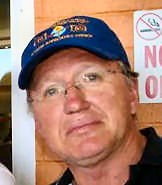
Allan George's Gems.
Contents
When the USAF nearly lost an SR-71.
Why do we gain weight as we age?
A tribute to a fine man.
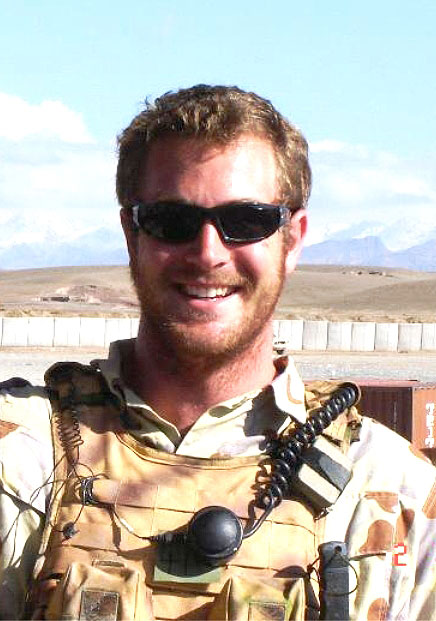
The 23rd of November recently passed. For some, it’s just another day. Unfortunately for others, it is not. I was there on the ground that day when one of our finest, Luke Worsley from 4 RAR Commando, was knocked. We were out in the middle of the Afghanistan Dasht and a long way from Australia. This story from within the SF community needs to be told to the Australian public but most of all the parents, wives, sons daughters, and family.
What the boys from Bravo Company 4 RAR (now 2 Commando Regiment), Special Operations Task Group (SOTG) rotation V (Roman numeral for 5), did for one of their own over an 18 hour plus period is something I will never forget. His mates did everything they could for him and then some.
We harboured up the vehicles, created the Vehicle Drop off Point (VDO) and the decision was made to move in on foot. Harbouring the vehicles was no easy feat as there were Land Rover SRVs, 4 and 6 wheel All-terrain Vehicles, Bushmasters and the Mother Ship. The Mother Ship was an up armoured 4 x 4 Mercedes Unimog that looks like something out of Mad Max. It had a pintle-mounted 50cal HMG mounted on top and a 7.62 Mag58 LMG mounted for the passenger.
The boys took off around dusk and started the stomp of about 3km (3.5hrs) over the mountainous terrain to the objective. Overwatch was established over the village and the boys went in. All seemed to be going well until the call of TIC (Troops in Contact) came over the radio. Echoes of rifle and intense machine gunfire could be heard across the valley.
Then we heard the words that no one wants to hear. Just after midnight on the 22nd and going into the early morning of 23rd November, I can remember hearing over the radio that we had a man down. All of us who were listening to the contact over the radio couldn’t believe it, we were waiting to hear who it was. The call sign of the soldier was sent over the radio and eventually, we worked out it was Luke.
We were in our harbour securing the vehicles, a few of us started to prepare to roll in and give them a hand. We could still hear the heavy fighting going on. Thankfully the boss made the call not to send us forward as we found out later on that the vehicle route into the village had been mined with IEDs. The boys had been on target for about 8 plus hours and dawn was not that far away. So the call was made to move out and that they would have to stretcher carry Luke back to the VDO some 3km away.
In this paragraph, I’m trying to give you some idea of the mindset and some of the setbacks the boys faced and overcame.
We also had Close Air Support, more commonly known as CAS. The boom and the shock wave from the explosion was massive. It broke the silence and even lit up our valley. When the CAS was called in we were in the VDO 3km away and we thought the boom and the shock wave from the explosion was massive. The main group was still in the vicinity of the village, they were only 700m to 900m away when the missile hit the target.
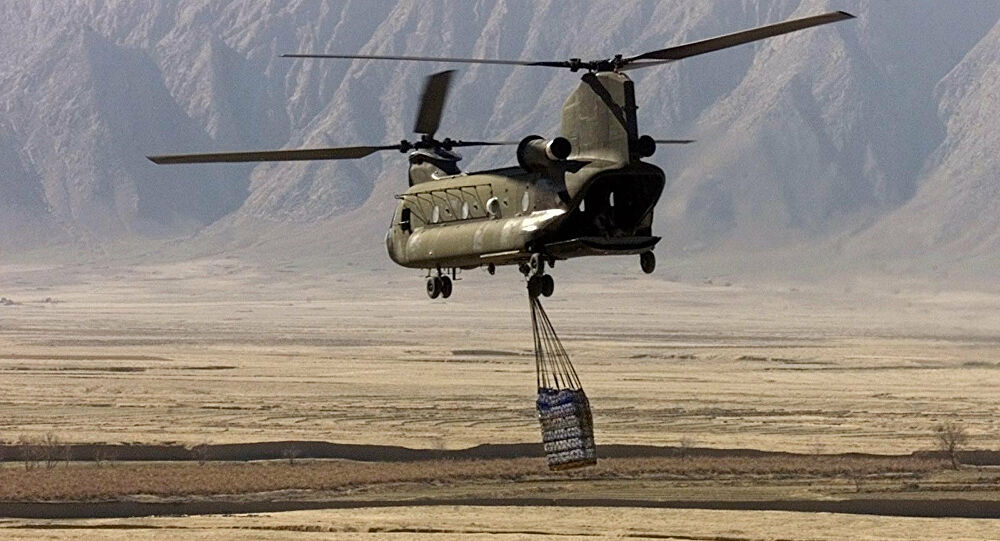
Choppers were called in to come and pick-up Luke. The Chinook, along with Gunship support, had to come from TK Airfield and were provided by the Dutch. They were requested to pick Luke from the village and take them back to TK Airfield for processing. As it turned out, we were told the chopper was on its way from TK, then the call came over the radio informing us it was being diverted to Forward Operating Base (FOB) Anaconda for another task. We were then told it was not coming directly to us from FOB Anaconda but now diverted to Kandahar. Once again we were then informed that the chopper did not have enough fuel to come to us from Kandahar, so it returned to TK airfield for refuel then finally on to our location.
I can remember standing there listening to the Company who were coming back, calling in and updating their position. Once we knew they were about 20 to 30 minutes out from the VDO, I told every spare body to go around to the vehicles, dig out the gas bottles and stove and boil some water. This was so they would have hot water for a brew when they returned.
Then I saw the first of two things that day that I wish every Australian could have seen. I can remember looking up and seeing the first member of the Company coming over the hill, then another and another. Then the rest of the boys were carrying Luke on the stretcher. Every man wanted to carry Luke. They had been at it for over 12 hours by now, they were all tired and they were hurt, but in true Grunt fashion they were not bloody beaten and at no time would they give up. At that very moment, I was thinking, how proud I was to be there. I just witnessed something un-bloody believable.
Before Luke was to be taken off the battlefield by chopper, he was placed in one of the Bushmasters. Everyone from the Company had the opportunity to go in, pay their respects and say goodbye, which they all did. I held his hand and said a prayer. I also told him that one day we will all be reunited in Valhalla and that he would not be forgotten.
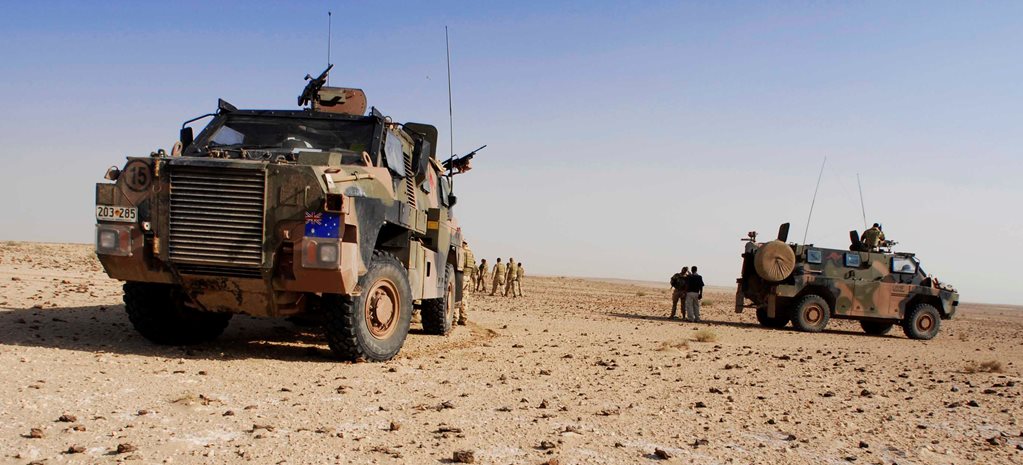
In addition to this, there was a young Mortarman. He was one of the boys that had just been out all night. He helped carry and was good friends with Luke. Unfortunately, he could not bring himself to go into the Bushmaster and say goodbye. I tried to convince him at the time that it was the right thing to do; however, he still could not bring himself to do it. I said to him that I completely understand. 30 minutes later at around 9 or 10ish, we received the call that the evac chopper was inbound.
Finally, we could hear the sound of the Chinook off in the distance. At this point, I picked myself up and went over to where the Mortars were. As I approached him I said, mate, this is the last chance you will get to say goodbye. He was also a religious man so I told him, this is the last chance to go in and say a prayer for him. To his credit, we both walked to the Bushmaster and I told him I would be right outside. He went in and farewelled his mate. Once we were back in Camp Russell, he came up to me and thanked me for what I had done.
So we loaded Luke onto the chinook and made sure everything was good to go. This is where I saw the second thing that the Australian public should know about. I was facing the chinook with the company spread out behind me in the defensive position. The position was spread out over approximately 500m on a slight hill that was running up from where we were. The CSM pointed behind me and said “hey DAZZ have a look at that.” I turned around and looked up and I could see the whole company, all standing to attention. They were next to their cars, some were standing by themselves, some were standing on Bushmasters, this was truly an amazing sight. These boys were paying their respect to a mate that they would never see again but would live on in their memories.
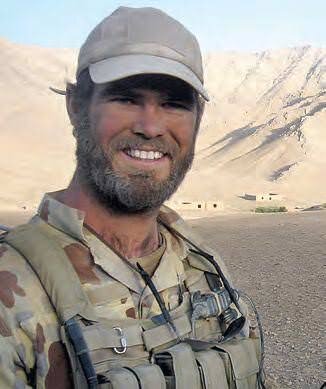
On our return to Camp Russell, we had a service and we were allowed a few beers. We were all in the building which is normally used as a recreation room and one of the blokes, whose name I cannot recall, played the Dire Straits song Brothers In Arms. Everyone stopped what they were doing and there was complete silence. Everyone banded together and paid their respect to Luke in their own way.
Once the Dire Straits song was finished a young man grabbed his guitar and went up the front of the recreation room. He was a strapping young lad who was already a legend within Bravo Company and 4RAR (2 Commando Regiment). Now you have to remember that this is in November of 2007. This man and his guitar started to play a song, a song that, funnily enough, still haunts me today. The song was “I hope you had the time of your life”, by Green Day. It was a pretty good rendition of the song that would give any musician a run for their money.
A few months after the events of the 22nd – 23rd this man with his guitar was awarded the Medal For Gallantry for his actions on that fateful night. A few years after that in 2013 this man went on to become a legend. He went on to become forever immortal.
The man with the guitar was Cameron Baird VC MG and he is the 100th recipient (sadly posthumously) of the Victoria Cross. A man truly worthy of this honour.
The same spirit that the ANZACs took with them to the shores of Gallipoli is still alive and well today. Up until now this story of the boys was just a personal memory that now will be hopefully told to the Australian public, but most of all the parents of these brave young lads.
Cheers
Darren Peters WO2 (Ret’d)
SOTG V
The SR-71
The recently released video below is very interesting. It tells of when one of the US's SR-71s had an engine failure and was in danger of being shot down by Soviet forces.
Windows File Recovery tool.
At last, Microsoft has a new Windows File Recovery tool lets you retrieve deleted documents. Although file recovery programs have been around for yonks, some of which are not free, it has taken until now for MS to release their own. It’s a Windows 10 program, if you’re not on 10 and haven’t updated with build 19041 or later (click HERE to see which version you have) it won’t work for you.
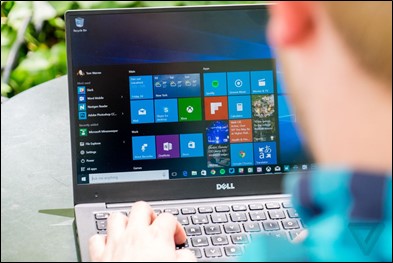
The beauty of this program is it will recover files from your hard drive, solid-state hard drive, USB sticks and memory cards – and it’s free.
It’s not as user friendly as a lot of other programs, it runs under what used to be called the Dos Prompt, people who have been using computers for many years will think they are back to using DOS and you have to wonder why MS would release a program without a graphics interface, perhaps in the future…..
Whether Microsoft’s tool can actually find and recover a file you’ve deleted depends on the drive. Deleted files aren’t removed from hard drives immediately but are often immediately removed from solid-state drives. If you’ve written a lot of data to a device like an SD card since you’ve deleted the file, it’s likely that the file’s data may have been overwritten. Even if you manage to recover a file, you may only get some of the file’s data—the file may be corrupted. You can only get whatever data is still on the drive. There are no guarantees here, and that’s why backups are so important.
The utility also has multiple modes intended for different situations and file systems.
Here’s how it works:
First you have to install the program.
-
Click HERE then GET and INSTALL the program.
-
Click START, in the list of programs on your computer, scroll down to the W section, right click WINDOWS FILE RECOVERY, then MORE, then PIN TO TASK BAR. This puts an icon on the task bar at the bottom of your screen. You can now use it whenever you want by just clicking the icon.
When you run the program, you’ll see a Command (AKA Dos) Prompt window with Administrator access, like the pic below. This is where you’ll run the File Recovery commands. If you’re an old DOS person it will look familiar, if not it can be a bit daunting, but you’ll soon get used to it.
There are lots of “switches” but MS gives you a serious hint by displaying them all before you use the program.
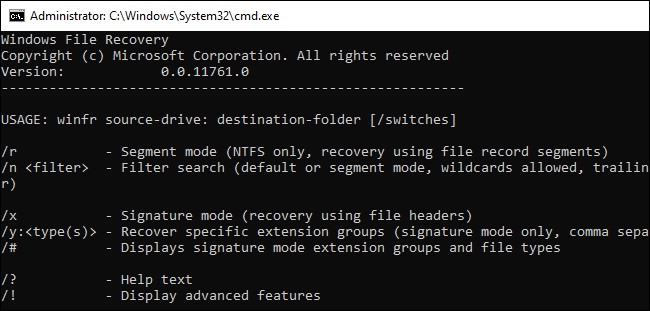
How to Recover Deleted Files on Windows 10
To use this tool, you will run the winfr command, you do this by clicking the icon you previously installed, specifying the drive you want to search for the deleted file, the destination to where you want to save it, (obviously you must save the deleted file to a different drive) and the various switches that control what the tool searches for and how it searches. That’s a lot of things to do and it all sounds daunting, but it’s not really. Here’s the basic format:
winfr source-drive: destination-drive: /switches
After running the command, the tool will automatically create a directory (folder) named “Recovery_[date and time]” on the destination drive you specify.
The utility also has multiple modes intended for different situations and file systems.
Which Mode Should You Use?
Before you continue, you should determine the “mode” you want to scan for the deleted file. There are three modes, Default, Segment, and Signature.
-
Default is the fastest mode,
-
Segment is similar but slower and more thorough.
-
Signature mode can search for files by type—it supports ASF, JPEG, MP3, MPEG, PDF, PNG, and ZIP files. (Searching for “ZIP” files will also find Office documents stored in formats like DOCX, XLSX, and PPTX.)
You’ll need to know what file system the drive you’ll be scanning is formatted with. To find this, open File Explorer, right-click the drive under This PC, and select “Properties.” You’ll see the file system displayed on the “General” tab. (See arrow below)
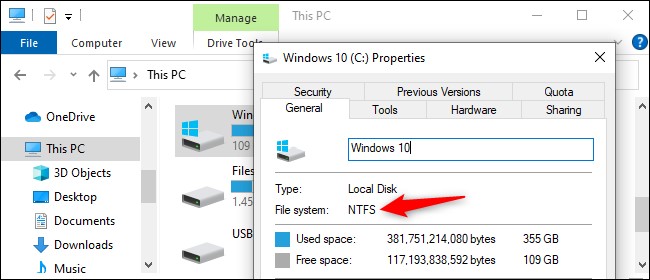
Here’s when you should use the different modes:
-
If you are trying to find a file you recently deleted on a drive formatted with NTFS, which is the default Windows 10 file system, Use Default mode.
-
If you’re scanning an NTFS drive in another situation—for example, if you deleted the file a while ago, you formatted the drive, or you’re dealing with a corrupt drive—try Segment mode first and then try Signature mode afterward.
-
Are you trying to find a file stored on a FAT, exFAT, or ReFS drive? Use Signature mode. The Default and Segment modes only work on NTFS file systems.
If you’re in doubt, just start with Default mode. You can then try Segment and then Signature if Default mode doesn’t work.
How to Recover a File in Default Mode
-
To use the default mode, you use the switch /n followed by a search path: To search for a file named document.docx, you’d use /n document.docx . You can also specify a full path to the file, such as /n \Users\Bob\Documents\document.docx
-
To search for all files that were in the Documents folder if your username is Bob, you’d use /n \Users\Bob\Documents.
-
To search with a wildcard, use a *. For example /n \Users\Bob\Documents\*.docx will find all DOCX files there were in the Documents folder.
So, to search for all DOCX files on drive C and copy them to drive D, you’d run the following command:
winfr C: D: /n *.docx
You will have to type “Y” to continue.
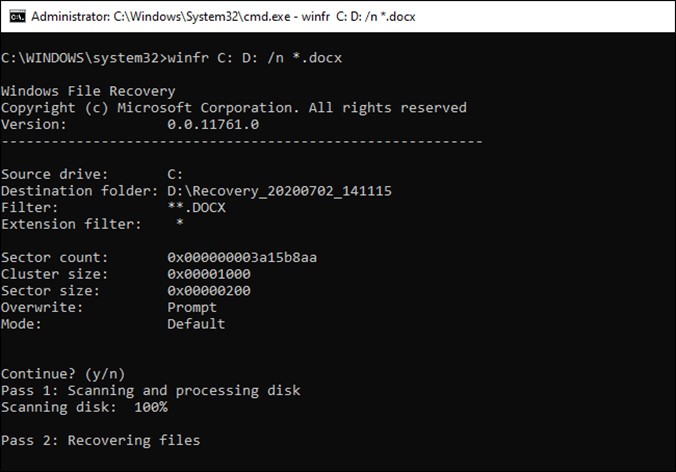
Once run, you’ll find the recovered files in a folder named “Recovery_[date and time]” on the destination drive you specified in the command line.
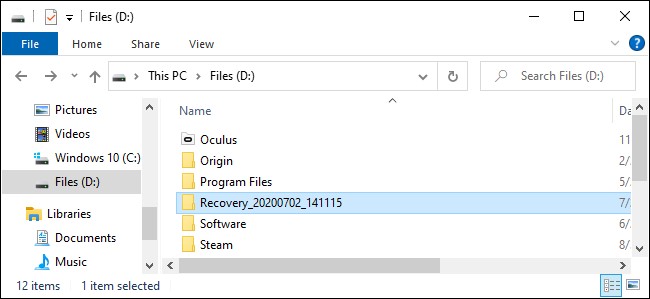
To find all files with a word in their name, use wildcards. So, to find all documents with “project” anywhere in their name, you’d run:
winfr C: D: /n *project*
You can specify multiple searches with multiple /n switches. So, to find all Word, Excel, and PowerPoint files, you’d run the following:
winfr C: D: /n *.docx /n *.xlsx /n *.pptx
To search for a specific file named important_document.pdf that was in the \Users\Bob\Documents folder on drive C:—and then save it to drive D:—you’d use:
winfr C: D: /n \Users\Bob\Documents\important_document.pdf
How to Recover a File in Segment Mode
Segment mode works almost exactly like Default mode. To use segment mode, which examines file record segments, you use /r in addition to /n. In other words, you can construct Segment mode recovery commands in the same way you construct Default mode commands—just add the /r . For example, to recover all deleted MP3 files from your C: drive and save them to your D: drive, you’d run:
winfr C: D: /r /n *.mp3
So, if a Default mode search doesn’t find what you’re looking for, add the /r and try again.
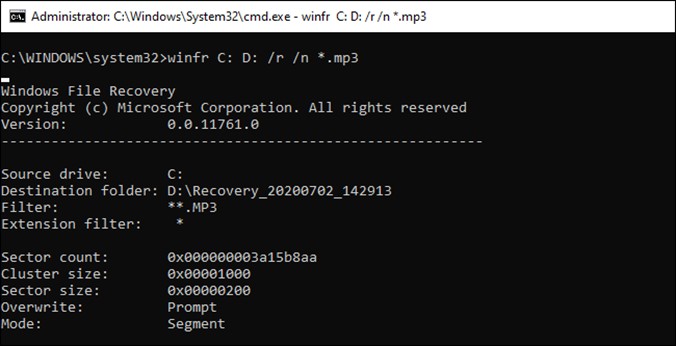
How to Recover a File in Signature Mode
Signature mode works a bit differently. It examines file types, so it can only find deleted files of certain file types. To use Signature mode, you use /x to specify Signature mode and /y: to list the file type groups you’d like to search for. Here’s a list of supported file types and the groups they’re sorted into, taken from Microsoft’s documentation:
|
ASF: |
wma, wmv, asf |
|
JPEG: |
jpg, jpeg, jpe, jif, jfif, jfi |
|
MP3: |
mp3 |
|
MPEG: |
mpeg, mp4, mpg, m4a, m4v, m4b, m4r, mov, 3gp, qt |
|
PDF: |
|
|
PNG: |
png |
|
ZIP: |
zip, docx, xlsx, pptx, odt, ods, odp, odg, odi, odf, odc, odm, ott, otg, otp, ots, otc, oti, otf, oth |
You can pull up this list at any time by running the following command: winfr /#
Note that the “ZIP” group includes ZIP files in addition to Microsoft Office and OpenDocument documents.
Let’s say you want to search drive E: for images in JPEG format and save them to drive D:. You’d run the following command:
winfr E: D: /x /y:JPEG
You can specify multiple file groups by separating them with a space. So, if you want to find JPEG files, PDFs, and Word documents, you’d run:
winfr E: D: /x /y:JPEG,PDF,ZIP

More information is available on Microsoft’s official winfr documentation page. You’ll find a detailed list of all winfr ‘s command-line options on that page, too. For a refresher on the basics, just run winfr or winfr /? .
There are also additional advanced options you can see by running winfr /!
Bloke pulls up to ask for directions:
“Excuse me” he says, “which is the quickest way to get to the Town Hall”
“Are you walking or driving” asks the bystander.
“Driving” says bloke
“Driving is definitely the quickest” says the bystander.
Could your tea towel give you food poisoning?
Raise your hand if you wash your kitchen tea towel every day. Not a lot of [people do, but new research has found that your humble tea towel could be putting you and your family at risk of food poisoning. So, you might want to start popping yours in the wash a lot more often after reading this.
After analysing 100 tea towels, scientists at the University of Mauritius found alarmingly high amounts of bacteria, including E. coli, which causes everything from food poisoning to urinary tract infections. The researchers supplied 100 tea towels to participants (36 were a mixture of cotton and nylon, 31 were pure cotton and 33 were pure nylon) and collected them after one month to analyse any bacteria present on them. The results revealed bacterial growth in 49 per cent of the tea towels, with cotton tea towels having the highest bacterial levels of all three kinds.
The study identified two factors that led to increased bacterial growth: multipurpose use and family size. Tea towels that were used for a variety of tasks (such as for wiping bench tops, in addition to drying hands and dishes) had the highest levels of bacteria. Likewise, the researchers found bacterial growth increased significantly in families with more people and particularly where children were present.
Now, before you get too worried, here’s some context:
-
The participants were asked questions about their lifestyle and family, including their tea towel use, diet and family size, however, they weren’t asked whether they had actually contracted food poisoning or other gastrointestinal illnesses during the one-month period.
-
The researchers also found that moist or “humid” tea towels had significantly higher traces of particular types of bacteria, such as coliforms, which are a class of bacteria typically found in the digestive tract and faeces of animals (including humans). While most coliforms are harmless, rare strains do exist that can cause serious illness.
What does it all mean?
Overall, while the research sheds some light on the state of the humble kitchen tea towel, we needn’t be too concerned. Most of the bacteria found were of the enterococcus and pseudomonas species, which don’t typically cause food poisoning, however, the research does give us some practical points to think about.
-
To limit your and your family’s exposure to bacteria, it’s best to wash your tea towel after every use. If this is impossible or unlikely, waiting until tea towels are dry will help, as dry tea towels have a lower bacteria load than damp ones.
-
Another tip is to use tea towels for single purpose and not for multiple tasks. You might consider colour coding your tea towels and using them for designated tasks; one for drying the dishes, another for drying hands, etc. This will also help to reduce the towel’s bacteria load.
Want to read more about the research findings? This article in The Conversation provides some useful insights.
There are three kinds of people in this world, those who are good at maths and those who aren’t.
It’s critical that you recognise this ‘silent killer’
Pancreatic cancer is deadly. Here's how to recognise the tell-tale signs.
Of the many types of cancer, one that receives less public attention than most, is pancreatic cancer. Which is somewhat surprising, given that by the end of the next decade, health professionals predict that pancreatic cancer will be the second leading cause of cancer-related deaths.
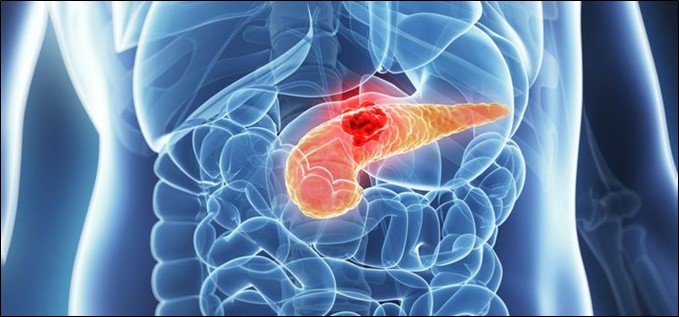
The other disturbing news is that pancreatic cancer has the highest mortality rate, with two-thirds of patients dying within 12 months of diagnosis and despite almost daily medical breakthroughs, the survival rate hasn’t changed significantly in recent years.
The pancreas is a gland in the digestive system, in the back of the abdomen behind the stomach. It has two major roles – to make digestive juices (enzymes) that help the intestines break down food and to produce hormones, including insulin, that regulate the body’s use of sugars and starches. The pancreas is joined to the bowel by a duct and it is in the cells lining this duct that the cancer first appears.
So how to recognise pancreatic cancer?
Signs and symptoms may not appear until the cancer is advanced and has spread to nearby organs, which is why it is often called the ‘silent disease’. Keep an eye out for dark urine, sudden weight loss, upper abdominal or back pain, loss of appetite, jaundice, nausea and either diarrhoea or constipation. If any of these symptoms has you worried, talk to your doctor.
So are you in the demographic for pancreatic cancer and what can you do to improve your chances of not getting it?
About 80 per cent of cases occur in people aged between 60 and 80. There are also strong genetic links and a recent study revealed that around 30 per cent of cases were linked to smoking. Excessive drinking and eating too much red meat have indirect consequences. Controlling both improves your chances of not contracting pancreatic cancer, as does eating vegetables. Excessive weight has been linked to around 10 per cent of pancreatic cancer cases, while sufferers of Type 2 diabetes are also at increased risk.
So is there any good news if you are diagnosed with pancreatic cancer?
The usual forms of cancer treatment are available, surgery, chemotherapy and radiotherapy and survival rates in recent decades have improved. WebMD reports that newer drugs on the market have the ability to attack specific parts of the cancer cells and immunotherapy is being researched, however the, disease is still considered difficult to cure as detection often occurs only after the cancer has spread to other organs.
Disclaimer: This article contains general information about health issues and is not advice. For health advice, consult your medical practitioner.+
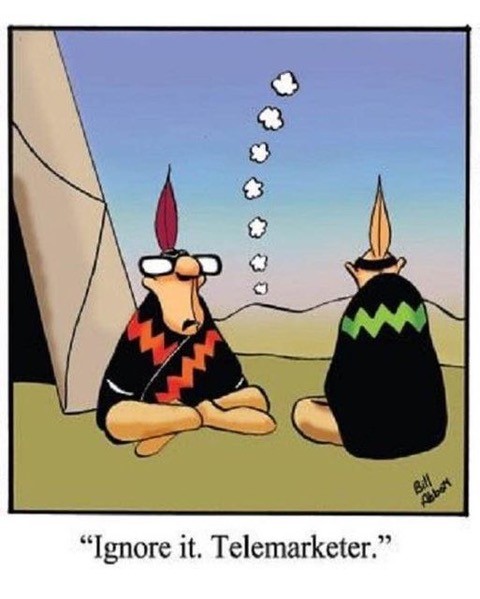
New study discovers the reason why we gain weight as we age.
Many people struggle to keep their weight in check as they get older. Swedish researchers now believe they have discovered the reason why this happens. According to the research from the Karolinska Institute, lipid turnover in the fat tissue decreases during ageing and makes it easier to gain weight, even if we don’t eat more or exercise less than before.
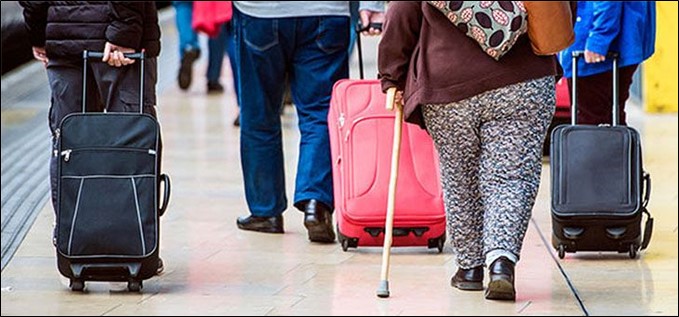
The scientists studied the fat cells in 54 men and women over an average period of 13 years. In that time, all subjects, regardless of whether they gained or lost weight, showed decreases in lipid turnover in the fat tissue, that is the rate at which lipid (or fat) in the fat cells is removed and stored. According to the study, those who didn’t compensate for that by eating fewer calories gained weight by an average of 20 per cent.
The researchers also examined lipid turnover in 41 women who underwent bariatric surgery (gastric band surgery) and how the lipid turnover rate affected their ability to keep the weight off four to seven years after surgery. The result showed that only those who had a low rate before the surgery managed to increase their lipid turnover and maintain their weight loss. The researchers believe these people may have had more room to increase their lipid turnover than those who already had a high-level pre-surgery.
The results indicate for the first time that processes in our fat tissue regulate changes in body weight during ageing in a way that is independent of other factors. This could open up new ways to treat obesity. Previous studies have shown that one way to speed up the lipid turnover in the fat tissue is to exercise more. This new research supports that notion and further indicates that the long-term result of weight-loss surgery would improve if combined with increased physical activity.

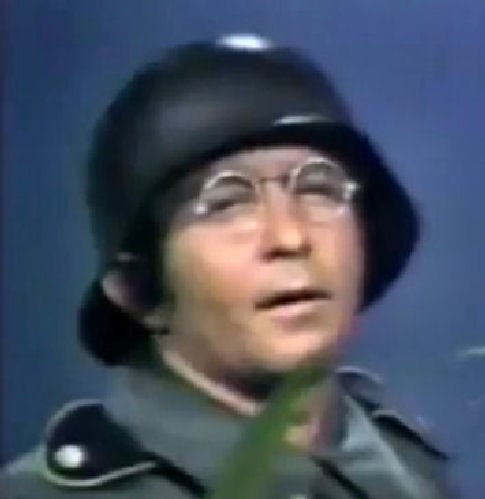
Intelesting - but stoopid!!
Back Go to page: 1 2 3 4 5 6 7 8 9 10 11 12 13 14 15 16 17 18 19 20 Forward